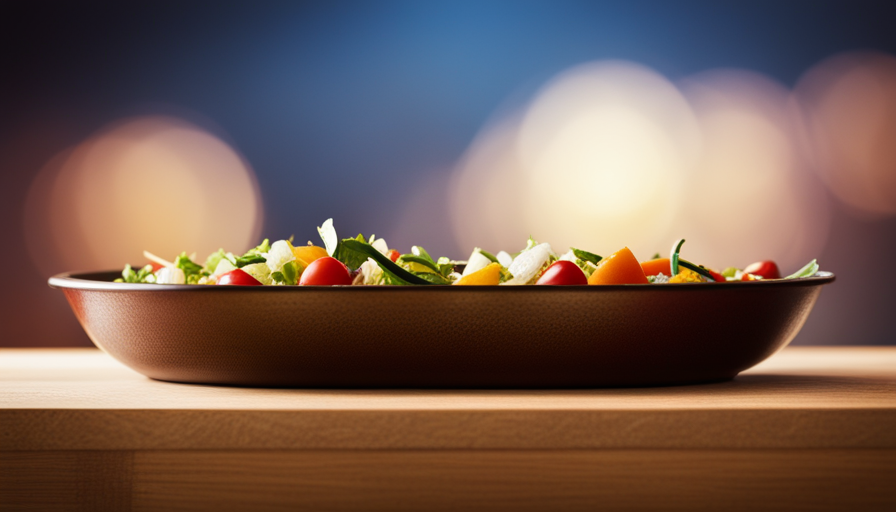Were you aware that adding nutritional yeast to your uncooked food recipes could enhance the nutritional value and impart a delightfully cheesy taste?
With its high protein content and abundance of vitamin B12, nutritional yeast is a powerhouse ingredient that can take your raw food creations to the next level. In fact, just one tablespoon of nutritional yeast contains around 2 grams of protein and 40% of your daily recommended intake of vitamin B12.
Whether you’re new to the world of raw food or a seasoned enthusiast, learning how to use nutritional yeast can greatly enhance your culinary repertoire. From creamy sauces and dressings to savory soups and salads, this versatile ingredient offers endless possibilities.
In this article, we’ll explore different ways you can incorporate nutritional yeast into your raw food recipes, as well as provide tips and tricks for storing and using it effectively. Get ready to elevate your raw food game with the power of nutritional yeast!
Key Takeaways
- Nutritional yeast is a versatile ingredient that adds a savory, cheesy flavor to raw food creations.
- It can be used in raw sauces, dressings, desserts, and smoothies to enhance flavor and create a creamy texture.
- Nutritional yeast is a key ingredient in making raw ‘cheese’ alternatives and can be combined with cashews, garlic, and lemon juice to create a cheesy sauce or dip.
- It is a high-protein food that is fortified with vitamin B12, making it a nutritious addition to a raw food repertoire.
Understanding the Benefits of Nutritional Yeast
You’ll be amazed at the incredible health benefits you’ll experience when you start incorporating nutritional yeast into your raw food diet. Not only does nutritional yeast provide a cheesy, nutty flavor to your dishes, but it also offers a wide range of nutrients that can boost your overall well-being.
Understanding the flavor profile of nutritional yeast is essential when using it in your raw food recipes. It adds a savory taste that’s often described as cheesy or nutty, making it a perfect substitute for dairy-based products. This is especially beneficial if you follow a vegan or dairy-free diet.
When it comes to choosing the right brand of nutritional yeast, it’s important to explore different options. Different brands may have slight variations in taste and texture, so it’s worth trying a few to find the one that suits your palate best. Look for brands that are fortified with B vitamins, as they’re essential for energy production and brain health.
Incorporating nutritional yeast into your raw food diet not only enhances the flavor of your dishes but also provides you with essential nutrients. So, don’t hesitate to give it a try and enjoy the incredible health benefits it has to offer.
Incorporating Nutritional Yeast into Raw Sauces and Dressings
To add a savory and cheesy flavor to your raw sauces and dressings, try incorporating nutritional yeast. Not only does nutritional yeast provide a burst of flavor, but it also offers several health benefits.
Here’s how you can easily incorporate nutritional yeast into your raw sauces and dressings:
-
Sprinkle it on top: Simply sprinkle a small amount of nutritional yeast on your sauce or dressing just before serving. This’ll give it a cheesy flavor and a subtle nutty undertone.
-
Blend it in: Add a tablespoon or two of nutritional yeast to your blender when making raw sauces or dressings. This’ll help to enhance the flavor and give it a creamy texture.
-
Use it in raw desserts: Nutritional yeast isn’t just for savory dishes. You can also incorporate it into raw desserts like cheesecakes or energy balls. It adds a unique flavor that complements the sweetness of the dessert.
-
Add it to raw smoothies: If you enjoy making raw smoothies, adding a teaspoon of nutritional yeast can give it a savory twist. It pairs well with ingredients like kale, spinach, and avocado, creating a delicious and nutritious smoothie.
Incorporating nutritional yeast into your raw sauces, dressings, desserts, and smoothies is a simple and effective way to enhance the flavor and nutritional profile of your dishes. Give it a try and enjoy the benefits it brings to your raw food creations.
Creating Cheesy Flavors with Nutritional Yeast
Looking to add a cheesy kick to your dishes without the guilt? Ever wondered how to create that savory flavor that leaves you craving more? Look no further than nutritional yeast! This versatile ingredient is not only vegan-friendly but also packed with essential nutrients like B vitamins and protein. With its cheesy and nutty flavor, nutritional yeast can easily be incorporated into various dishes, including raw desserts.
To create cheesy flavors with nutritional yeast, you can use it in combination with other ingredients like cashews, garlic, and lemon juice. These ingredients can be blended together to make a creamy and flavorful sauce that can be drizzled over salads or used as a dip for raw veggies.
To help you visualize the possibilities, here’s a simple table to guide you:
| Ingredient | Amount | Purpose |
|---|---|---|
| Nutritional Yeast | ¼ cup | Adds cheesy flavor |
| Cashews | 1 cup | Creaminess |
| Garlic | 2 cloves | Savory taste |
| Lemon Juice | 2 tablespoons | Brightens the flavors |
By incorporating nutritional yeast into your raw desserts, you can also create guilt-free treats that still satisfy your cheesy cravings. You can sprinkle it on top of raw pizza, mix it into raw mac and cheese, or even blend it with nuts and dates to create a cheesy, sweet crust for a raw cheesecake. The possibilities are endless!
So go ahead and experiment with nutritional yeast in your raw dishes and desserts. It’s a simple and delicious way to add that cheesy flavor you love, while keeping your meals vegan-friendly and nutritious.
Using Nutritional Yeast in Raw Soup Recipes
Get ready to elevate your raw soups to the next level with a secret ingredient that adds a cheesy, savory twist you won’t be able to resist! Nutritional yeast isn’t just a great source of essential nutrients like B vitamins, but it also brings a rich, cheesy flavor to your raw soup recipes.
When using nutritional yeast in raw soups, start by adding a small amount and gradually increase to suit your taste. This’ll help you achieve the perfect balance without overpowering the other flavors in your soup. Nutritional yeast can be added directly to the soup or mixed with other ingredients before blending, depending on the recipe.
In addition to raw soups, nutritional yeast can also be incorporated into other raw dishes to enhance their flavors. For example, you can sprinkle it on top of raw desserts like cashew-based cheesecakes or use it to make a creamy, cheesy sauce for raw lasagna. It can also be used in raw dips and spreads, giving them a tangy, cheesy kick.
So, next time you’re preparing a raw soup or experimenting with raw desserts, don’t forget to reach for the nutritional yeast. Its cheesy, savory taste’ll take your dishes to a whole new level of deliciousness!
Sprinkling Nutritional Yeast on Raw Salads and Veggie Dishes
Add a touch of ‘cheesy magic’ to your vibrant salads and veggie dishes with a sprinkle of nutritional yeast. This secret ingredient not only adds a deliciously cheesy flavor, but it also provides a nutritional boost to your raw food creations. Nutritional yeast is a versatile ingredient that can be used in various ways, including in raw smoothies and desserts.
When it comes to salads, sprinkling nutritional yeast on top adds a unique savory flavor that complements the freshness of the vegetables. It can be used as a substitute for Parmesan cheese, giving your salads a cheesy taste without the dairy. You can also mix it with your favorite salad dressing to create a creamy and tangy dressing that will take your salad to the next level.
In addition to salads, nutritional yeast can be incorporated into raw smoothies. It adds a depth of flavor and a hint of cheesiness that pairs well with fruits and vegetables. Simply blend it with your favorite smoothie ingredients for a nutritious and flavorful drink.
Furthermore, the versatility of nutritional yeast extends to raw desserts. It can be used to create a creamy and cheesy flavor in raw cheesecakes, puddings, and even ice creams. Nutritional yeast adds a unique twist to traditional dessert recipes, making them healthier and more flavorful.
Nutritional yeast is a fantastic ingredient to use in raw salads and veggie dishes. Its cheesy flavor and versatility make it a must-have in any raw food kitchen. So go ahead, sprinkle some nutritional yeast on your next salad or blend it into your favorite smoothie for that extra touch of deliciousness.
Making Raw "Cheese" with Nutritional Yeast
Now that you’ve mastered the art of sprinkling nutritional yeast on your raw salads and veggie dishes, let’s take your raw food game up a notch. Get ready to dive into the world of making raw ‘cheese’ alternatives with the help of nutritional yeast.
Nutritional yeast is a key ingredient in creating creamy and flavorful raw ‘cheeses’ that’ll satisfy your cravings without any dairy. The unique umami taste of nutritional yeast adds a cheesy flavor to your creations, making them a delicious addition to your raw food repertoire.
To make a simple raw ‘cheese’ spread, combine soaked cashews, nutritional yeast, lemon juice, garlic, and a pinch of salt in a food processor. Blend until creamy and smooth. This versatile spread can be used as a dip for fresh veggies, a filling for raw wraps, or even as a sauce for zucchini noodles.
You can also incorporate nutritional yeast into raw dips and spreads to enhance their flavor. Add a tablespoon or two of nutritional yeast to your favorite raw hummus recipe for an extra boost of cheesy goodness. Or mix it into a raw tahini dressing for a tangy and creamy twist.
So go ahead and experiment with making raw ‘cheeses’ and incorporating nutritional yeast into your dips and spreads. Your taste buds’ll thank you for the flavorful and nutritious creations you’ll be whipping up.
Boosting Protein and Vitamin B12 with Nutritional Yeast
Maximize your protein intake and boost your vitamin B12 levels by incorporating nutritional yeast into your diet. Not only is nutritional yeast a delicious seasoning alternative, but it also offers numerous health benefits. This inactive form of yeast is a complete protein, meaning it contains all nine essential amino acids that your body needs. It is especially beneficial for those following a plant-based diet as it provides a concentrated source of protein. Additionally, nutritional yeast is fortified with vitamin B12, a nutrient that is primarily found in animal products. Vitamin B12 is essential for maintaining healthy nerve cells and red blood cells, as well as boosting energy levels.
To give you an idea of the nutritional value of nutritional yeast, take a look at the following table:
| Nutrient | Amount per serving (1 tablespoon) |
|---|---|
| Protein | 2 grams |
| Vitamin B12 | 4 micrograms |
| Fiber | 1 gram |
| Iron | 1.5 milligrams |
| Zinc | 0.5 milligrams |
By incorporating nutritional yeast into your meals, you can easily increase your protein intake and boost your vitamin B12 levels. Sprinkle it on top of salads, soups, or roasted vegetables for a savory and cheesy flavor. So why not give nutritional yeast a try and enhance your diet with its impressive nutritional profile?
Experimenting with Nutritional Yeast in Raw Pizza and Pasta
Try sprinkling some of this cheesy and protein-packed seasoning on your favorite raw pizza or pasta dishes for a delightful twist! Nutritional yeast can be a versatile ingredient when it comes to experimenting with raw food.
Here are three ways to incorporate it into your raw desserts and bread recipes:
-
Raw Pizza: Add a sprinkle of nutritional yeast on top of your raw pizza crust before adding your favorite toppings. The savory, cheesy flavor of the yeast will complement the fresh ingredients and give your raw pizza a delicious umami taste.
-
Raw Pasta: Toss your raw pasta with a sprinkle of nutritional yeast for a cheesy and flavorful twist. The yeast will enhance the taste of the raw noodles and provide a rich and creamy texture to your dish.
-
Raw Bread: When making raw bread, try incorporating nutritional yeast into your recipe. This will not only add a cheesy flavor to your bread but also boost its protein content. Nutritional yeast can be used as a natural leavening agent in raw bread recipes, giving them a light and fluffy texture.
By experimenting with nutritional yeast in your raw desserts and incorporating it into your raw bread recipes, you can enjoy the benefits of added protein and a cheesy flavor in your raw food creations. Give it a try and see how it enhances the taste and nutritional value of your favorite raw dishes!
Adding Nutritional Yeast to Raw Snacks and Crackers
Enhance the flavor and boost the protein content of your favorite raw snacks and crackers by sprinkling them with this cheesy and protein-packed seasoning. Nutritional yeast is a versatile ingredient that can be incorporated into a variety of raw desserts. It adds a delicious cheesy flavor and a nutritional punch to your treats.
When it comes to incorporating nutritional yeast into raw desserts, the possibilities are endless. You can add it to energy balls, raw brownies, or even raw cheesecakes for a savory twist. The cheesy flavor of nutritional yeast pairs well with the sweetness of raw desserts, creating a unique and delicious combination.
To get the best results, it’s worth trying out different brands of nutritional yeast. Each brand has its own distinct flavor profile, so experimenting with different options can help you find the one that suits your taste buds the best. Some brands may have a stronger cheesy flavor, while others may be milder. It’s all about finding the right balance for your raw desserts.
Incorporating nutritional yeast into your raw snacks and crackers is a simple and effective way to add flavor and nutrition. So go ahead, sprinkle some nutritional yeast on your favorite raw treats and enjoy the cheesy goodness it brings.
Tips and Tricks for Storing and Using Nutritional Yeast
Make the most of your culinary adventures with nutritional yeast by discovering these helpful tips and tricks for storing and utilizing this versatile ingredient in your kitchen.
Storing nutritional yeast properly is important to maintain its freshness and maximize its shelf life. To keep it fresh, store nutritional yeast in an airtight container in a cool, dry place, away from direct sunlight. This will help prevent moisture and air exposure, which can lead to spoilage. Additionally, refrigerating or freezing nutritional yeast can extend its shelf life even further.
When using nutritional yeast in your recipes, remember that a little goes a long way. Start with a small amount and adjust to taste. Nutritional yeast can be used as a seasoning or topping for various dishes, such as salads, soups, pasta, and popcorn. Its cheesy, nutty flavor adds a savory umami taste to your favorite dishes.
In addition to its delicious taste, nutritional yeast also offers several health benefits. It’s a great source of protein, fiber, and essential vitamins, including B-complex vitamins. These vitamins are important for energy production, metabolism, and overall brain health. Nutritional yeast is also a complete protein, meaning it contains all nine essential amino acids that your body needs.
So, make sure to store your nutritional yeast properly and experiment with incorporating it into your favorite recipes. Enjoy the added flavor and health benefits that this versatile ingredient brings to your raw food creations.
Frequently Asked Questions
Can nutritional yeast be used as a substitute for cheese in non-raw recipes?
Yes, nutritional yeast can absolutely be used as a substitute for cheese in non-raw recipes! It may sound too good to be true, but this versatile ingredient is a game-changer for vegans and those looking for a healthier alternative.
Not only does it provide a cheesy flavor, but it also packs a punch of vitamin B12, which is essential for a vegan diet. So go ahead and sprinkle some nutritional yeast on your pasta, casseroles, or even popcorn for that cheesy goodness without the guilt!
Is nutritional yeast safe to consume for individuals with yeast allergies?
Yes, nutritional yeast is generally safe to consume for individuals with yeast allergies. Despite its name, nutritional yeast is actually a deactivated form of yeast and doesn’t contain the live yeast that can trigger allergies. Many people with yeast allergies can tolerate nutritional yeast without any issues. However, it’s always best to consult with a healthcare professional if you have any concerns or specific dietary restrictions.
How do I know if the nutritional yeast I purchased is still good to use?
To test the freshness of nutritional yeast, start by checking the expiration date on the packaging. If it’s already passed, it’s best not to use it.
Additionally, look for any signs of discoloration or a rancid smell, as these indicate spoilage.
Properly storing nutritional yeast is essential for maintaining its freshness. Keep it in an airtight container in a cool, dry place, away from direct sunlight or moisture. This will help extend its shelf life and ensure its quality.
Can nutritional yeast be used as a seasoning in other dishes besides raw food recipes?
Yes, nutritional yeast can definitely be used as a seasoning in various dishes besides raw food recipes. It’s widely recognized as a flavor enhancer and is particularly popular in vegan cooking. Nutritional yeast adds a delicious cheesy and nutty flavor to dishes like soups, stews, sauces, and even popcorn. It’s a versatile ingredient that can be sprinkled on top of salads, pasta, or roasted vegetables, providing a savory and umami-rich taste to your meals.
Are there any potential side effects or risks associated with consuming nutritional yeast?
While there aren’t any known serious side effects of consuming nutritional yeast, some people may experience mild digestive issues like bloating or gas. However, these symptoms are rare and usually temporary. In fact, nutritional yeast has been linked to potential health benefits such as improved digestion and a strengthened immune system. It’s also low in calories and packed with nutrients, making it a great addition to a weight loss diet. For instance, a study showed that incorporating nutritional yeast into meals helped individuals feel more satisfied and may aid in weight management.
Can Nutritional Yeast Be Used in a Raw Food Diet for Cats?
Nutritional yeast can be beneficial when transitioning raw food diet cats. Its savory flavor can entice picky eaters, and the B vitamins can support their overall health. However, it should be used in moderation as a supplement rather than a primary source of nutrients.
Conclusion
So there you have it, now you know how to use nutritional yeast to enhance the flavor and nutritional content of your raw food dishes. By incorporating this versatile ingredient into sauces, dressings, soups, salads, and even snacks, you can create delicious and nutritious meals.
Remember, nutritional yeast is packed with protein and vitamin B12, making it a great addition to any plant-based diet. So go ahead, get creative in the kitchen and start enjoying the benefits of this ‘cheesy’ secret ingredient.










